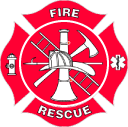
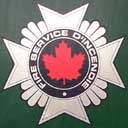
The History of the "Maltese Cross"
by Mica Calfee
One
can easily find a hundred web sites that will tell
you that the symbol of the fire service comes from
the "Knights of Malta" and their battles
with Ottoman pirates or the Saracens. The story is
that these knights had a cross on their tunics and
that the Saracens used fire as a weapon against them. All of this is true. There were
many of these knights who risked their lives to save their
comrades or structures from the fires. But there
is much more to the story than that. These knights were incredibly brave and one battle has them winning against unbelievable odds.
PLEASE NOTE: This article is not meant to suggest that the current emblem of the United States fire service did not evolve from the cross of the Knights of St. John. All the contributors and sources of the article suggest, is how it may have done so and the history of those brave knights and of the emblem.
In his book "Badges of the Bravest" Gary Urbanowicz states that the first use of a Maltese cross was adopted by FDNY in 1865. In Brooklyn they apparently adopted it in 1882.
"The article appeared in the September 19, 1882 issue of the Brooklyn Eagle. It says: 'Commissioner Partridge has decided to make a change in the design of the badges of the Fire Department. The present badge is of nickel and in the form of a four-leaf clover. The new one is in the design of a Maltese cross, the old sixth army corps badge. Those of the Commissioner, deputy, chief engineer and assistants are gold-plated, and those of the privates are German silver. The present badges have been in use so long that some of them have found their way into the possession of parties who are not entitled to them, and from whom they cannot be obtained. Hence the change.'" - Gary Urbanowicz
As mentioned
elsewhere on this site, the Civil War
had much
influence
on the traditions of the fire service.
We
can probably all agree that the firefighters emblem
is an attractive design. It is unique and does
an excellent job of representing that, whatever
it is
attached to, is fire service related.
NEW! A website that talks more about the cross of the Knights of St. John, and its relationship to the U.S. Fire service emblem,
can be found here.http://www.firerescue.navajo.org/Logo.html
These “Knights
of Malta”.
There were "Knights of Malta." In fact they still
exist, although, this
was not their actual name. A more proper name
might have been, “Order
of St John of Jerusalem, Knights Hospitaller.” This was a Benedictine
order of monks that was founded around 1100 AD. They maintained a hospital
in Jerusalem for pilgrims after the first crusade. But soon after that, their
mission became that of defense and they later became a military order under
it's own charter, charged with the care of and defense of the holy land and
pilgrims. After the loss of the holy land, (Jerusalem fell in 1187) this
military order resided in several places. These locations include Rhodes
and Malta.
It is because of the many places they occupied, that to this day they are
known as, “The Sovereign Military Hospitaller Order of St. John of
Jerusalem of Rhodes and of Malta” (abbreviated SMOM). A small sovereign
piece of land in Rome is said to house the remaining knights of this order.
These
knights
were a major military force for hundreds of years.
What
about the fire?
The
use of fire as a weapon became popular during the
crusades. Skill in glass blowing and other technologies
made it possible to hurl flammable liquids or, what
we today might call, “Molotov Cocktails” down
upon enemies attacking your battlements. The Knights
of St. John were undoubtedly involved in such battles.
Some of the more famous battles probably involved
the Saracens. The Saracens used fire in many ways.
Besides throwing fire bombs, they would sail vessels
containing flammables into crusader’s ships.
Many knights were reported to be courageous and heroic
in their attempts to rescue their fellow knights
in such battles and in the face of such a terrifying weapon.
More
about Malta.
On
August 15, 1309 the knights captured the island of
Rhodes. A more famous order of military knights was
the “Knights Templar”. This order was
dissolved in 1312 and most of its property was given
to the Hospitallers. Now known as “The Knights
of Rhodes” they were forced to become a more
militarized force, fighting especially with the Barbary
pirates. They withstood two invasions in the 15th
century, one by the Sultan of Egypt in 1444 and another
by Mehmed II in 1480, who after the fall of Constantinople
made the Knights a priority target.
In
1522 an entirely new threat arrived from turkey,
when 400 ships under the command of “Suleman
(Suleiman) The Magnificent” brought 200,000
men to Rhodes. To repel this force the knights had
only the walls of the city and about 7000 men. The
resulting siege lasted six months, at the end of
which the survivors were allowed to leave Rhodes
and retreated to the Kingdom of Sicily. In exchange,
the knights promised to leave Suleman's minions in
peace. But after a time, they were once again fighting
each other.
The
knights eventually moved to the island
of Malta. They were allowed
to relocate to the island of Malta under a 1530 order
of Pope Clement VIII. But they had to pay rent to
a feudal landlord, the king of Sicily. This rent
consisted on one “Maltese Falcon” a year.
This historic fact was the basis of the plot of Hammett’s
famous book and subsequent movie, The Maltese
Falcon.
They
built large fortifications on malta including St.
Elmo's Fort. Finally they acquired the name, “The
Knights of Malta”. From Malta they launched
attacks on the Barbary Pirates and became enemies
of the Ottoman Empire once again. In 1564 Suleiman
again set his sights on the knights. He sent his
armada of over 170 ships to Malta with over 40,000
well trained troops and many thousand more slaves
and mercenaries. Malta endured many sieges starting
in 1565 but remained victorious. An amazing account
of the siege of Malta can be found HERE.
It
was only in 1798 that Malta fell at the hands of
Napoleon. But it was through trickery rather than
military might. Napoleon asked for safe harbor and
then, once allowed inside the defenses, turned on
his hosts. The order also had a rule that prohibited
fighting with other Christians. They had also, previously,
lost much of their property and resources because
it was in France and had been confiscated.(4) Members
of the order were given shelter in various countries.
It has survived in several forms since then.
The
Sovereign Military Hospitaller Order of St. John
of Jerusalem of Rhodes and of Malta, better known
as the Sovereign Military Order of Malta or SMOM,
is a Catholic order which claims national sovereignty
and has been granted permanent observer status at
the United Nations. (It's claims of sovereignty are
not without dispute.) SMOM is considered to be the
most direct successor to the medieval Knights Hospitaller,
also known as the Knights of Malta, and today operates
as a largely charitable and ceremonial organization.
There are several other organizations who attempt
to capitalize on the name and call themselves "Knights
of Malta".
What
about the Cross?
By all accounts, the knights
of Malta did wear a medieval cross. It looked something
like
this.
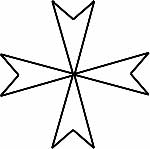
The
Reverend Dr. Michael Foster in his "History of the Maltese Cross", defines a "Maltese
Cross" as one, “made from four straight
lined pointed arrowheads, meeting at their points,
with the ends of the arms consisting of indented
'v's" (2) In
some sources this is actually known as a "Cross
Patee-Nowy" (Pattee-Nowee).(3) They
state that this means something like a "swallow
tailed cross" A student of heraldry, who has
contacted me, disputes this definition because the
term "nowy" refers to the bump as is found
on the fire service cross. (More about that later.)

A Present Flag of The SMOM.
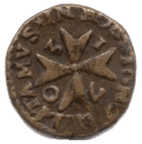
A Maltese coin minted in 1703.
This
cross was probably adopted while the order was at
Malta. The cross of Rhodes was slightly different.
One
can find resources that give meaning to each of the
four branches of any crusader cross. A somewhat thorough
website from San Diego suggests that each point,
of the Maltese Cross, was said to stand for eight
aspirations or obligations. (1)
"Live in truth"
"Have faith"
"Repent of sins"
"Give proof of humility"
"Love justice"
"Be merciful"
"Be sincere and whole-hearted"
"Endure persecution"
From: http://www.publicsafety.net/maltese.htm
These
aspirations or obligations are reflected in the Beatitudes
and in fact many resources simply state that the
points are meant to represent just that.
"Blessed are the poor in spirit."
"Blessed are those who mourn."
"Blessed are the meek."
"Blessed are they who hunger and thirst for righteousness."
"Blessed are the merciful."
"Blessed are the pure at heart."
"Blessed are the peacemakers."
"Blessed are they who are persecuted for righteousness."
-Matthew 5: 3-12
If we look at the
emblems still in use by some of the worlds oldest
fire departments we can see this cross. One of the
most obvious uses of a version of the patee-nowy
can be seen in Canadian fire brigades.

Also
in Great Britain, Canada and other such countries,
the Maltese cross has evolved into different versions
of an eight-pointed star.
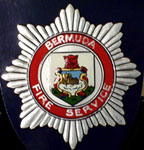 Or
Or 
Courtesy RC Etheridge
This
is known as the “Star of Jerusalem” design,
which suggests some relationship to the knights.
Commonly the eight points are assigned virtues, much
the same way the knights did to the points of the
cross. The British fire service's badge design is
said to represent:
Tact, Gallantry, Dexterity, Observation, Perseverance, Loyalty, Explicitness,
Sympathy.
These are very reminiscence of the aspirations of the knights or the chivalric
virtues. (If not exactly the same.)
One
does not have to look very far to find other stylized
modifications of this symbol.
Below is the version found on fire stations in Maui, Hawaii.
Anyone know the history of this one?
This does not look much like any seen anywhere else.
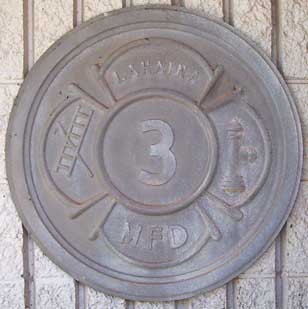
For more information on
the Hawaiian fire service, click on photo.
The Cross of St. Florian Idea
There are those people or websites who claim that the fire service cross is somehow derived from the Cross of St. Florian. This is a dubious assertion at best. The following serves to report on this claim. In no way should this be considered an endorsement of the idea.
Click here for possibly the best discussion found on the subject. This by Chaplain /Reverend, Don Engebretson of the Town of Antigo Volunteer Fire Department.
http://nwseelsorger.blogspot.com/2008/03/firefighters-cross.html
Here is
a site that claims that this,  is
a "St Florian Cross Maltese."
is
a "St Florian Cross Maltese."
http://www.st-florian-medal.com
Wiki
- (Should be considered somewhat unreliable.) "The
cross of St. Florian is widely used by fire services
to form their emblem."
http://en.wikipedia.org/wiki/Saint_Florian
An
online Encyclopedia showing a "typical St. Florian
cross."
http://www.nationmaster.com/encyclopedia/Saint-Florian
Here
is a fire department that proclaims, unequivocally,
that the fire service emblem is based upon the design
of the
St. Florian
cross. It says:
"The badge of a fireman is the St. Florian
Cross (oftentimes mistakenly called the Maltese Cross).
This St. Florian Cross is a symbol of protection
and a badge of honor. Its story is hundreds of years
old."
It goes on to say, "The St. Florian Cross is
oftentimes confused for the Maltese cross."
http://www.bbvfd.com/florian.php
Note: This story told in the above website is a little
confusing
because they mix the story of the Knights of St.
John and the St. Florian cross. No real references
are given other than a link to a Wiki site about
the
Maltese cross, etc.
Resources:
(1)
http://www.publicsafety.net/maltese.htm
(2) http://www2.prestel.co.uk/church/oosj/cross.htm
(3) http://www.townofstephenvillecrossing.com/maltesecross.htm
(4)http://www.maltavoyager.com/history_orderfall.html
http://www.smom.org/worldwide.php
http://www.orderofmalta.org/storia.asp?idlingua=5
http://www.hantsfire.gov.uk/servicebadgesorigin
http://www.fireservicehistory.co.uk/badge.htm
http://www.townofstephenvillecrossing.com/maltesecross.htm
http://www2.prestel.co.uk/church/oosj/cross.htm
http://www.minnesotafireservice.com/funstuff_history_of_firefighting.html
http://www.datasync.com/nexus/fire/cross.htm
http://www.local1259iaff.org/maltesecross.html
http://www.ci.boston.ma.us/bfd/history/maltese_cross.htm
http://www.smom-za.org/smom/Maltese%20Cross/symbolism.htm
http://www.seiyaku.com/customs/crosses/maltese.html
http://www.seiyaku.com/customs/crosses/index.html
http://www.tattoodaily.com/mag/maltese_cross.html
http://www.ordotempli.org/history_of_the_knights_templar.htm
http://en.wikipedia.org/wiki/Knights_Templar
http://www.mystae.com/restricted/streams/masons/templars.html
http://www.riotacts.com/